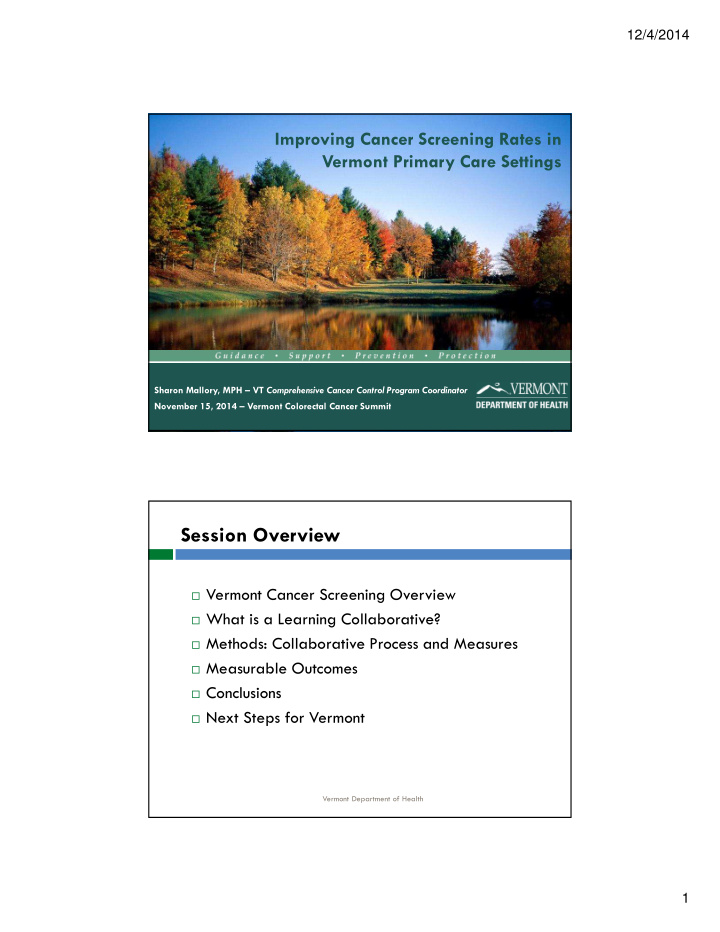



12/4/2014 Improving Cancer Screening Rates in Vermont Primary Care Settings Sharon Mallory, MPH – VT Comprehensive Cancer Control Program Coordinator November 15, 2014 – Vermont Colorectal Cancer Summit Session Overview � Vermont Cancer Screening Overview � What is a Learning Collaborative? � Methods: Collaborative Process and Measures � Measurable Outcomes � Conclusions � Next Steps for Vermont Vermont Department of Health 1
12/4/2014 Cancer Screening Rates: Vermont Compared to U.S. VT U.S. 87% 84% 82% 79% 72% 66% Breast Cancer Screening Cervical Cancer Screening Colorectal Cancer (women aged 50-74) (women aged 21-65) Screening (men and women aged 50-75) Note : Rates are based on most recent USPSTF guidelines. Rates are age adjusted to the 2000 U.S. standard population Vermont Department of Health Data Source: BRFSS 2012 Learning Collaborative – Cancer Screening � Collaborative model � Learning model for primary care providers � Founded from evidence-based Institute for Healthcare Improvement, Breakthrough Series � Learn from each other & experts to foster sustainable change � Use evidence-based cancer screening guidelines � Planning & implementation, a collective effort Vermont Department of Health 2
12/4/2014 Collaborative Structure � Nine month series (May 2013—January 2014) � Breast, cervical and colorectal cancer screening � Learning sessions: 5 in-person & 4 by phone; expert discussion, evidence-based methods & case studies � Educational Credits : CME/CEU/MOC Available � Action periods: PDSA cycles between meetings � Measurement & evaluation: p ractice-driven data creates a baseline & identifies change opportunities Vermont Department of Health Focus on Evidence-Based Approaches 3
12/4/2014 Evidence-Based Positive Clinic Screening � System to routinely notify all patients when due for cancer screening (phone, mail or email) � Charts provide patients’ current cancer screening status � Charts of patients due for screening routinely flagged before or at time of clinic visits � During office visits, Providers make screening referrals � Provide scheduling assistance for screening appts (i.e., colonoscopy) and patient navigator type services � Cancer educational materials placed in multiple clinic areas � System to review practice/provider level screening rat es Common Practice Performance Measurement � Measures � % receiving screening tests (USPSTF) � % notified of screening results � % with positive results receiving coordinated follow-up care � Process � Manual/electronic chart review � Data entry spreadsheet provided � Data presented at each session Vermont Department of Health 4
12/4/2014 Results – General � Participation: � 4 Vermont primary care practices ( combined patient panel of 14,000, 22 providers [MD, NP , PA, RN]) � 5 PCP case studies and 6 cancer specialists � Outcomes: � 75% strongly agreed knowledge of cancer screening and how to improve outcomes increased � 100% increase in using ability of using current systems to understand their screening rates � 100% implemented patient screening notification systems � 100% strong confidence that implemented changes will be sustained Vermont Department of Health Results – Patient Panel � Changes not fully comparable Example Practice 1 � All practices increased* % Colorectal Cancer (% Screened ) 100% 77% 78% 82% 85% screened for all 3 cancers 90% 75% 78% 80% (*1 practice maintained 92% breast screening ) 70% 60% � Results & follow-up care 64% 50% 40% � All had significant barriers with 30% documentation (getting info. from 20% 10% specialists) 0% � All practices began implementing rapid improvement changes %50-75 Target % screened age 50-75 Vermont Department of Health 5
12/4/2014 Conclusions � Series effective in creating primary care setting cancer screening improvements � Scope may be small, but practice change is significant and sustainable Facilitators Barriers � Primary care case-studies � Recruitment challenges � Offering CME/CEU credits � 3 cancer approach complicated the message � PDSA focus allowed for structured action plans � Time commitment high for PCPs � Planning & implementation time intensive Vermont Department of Health Next Steps � Considering e-format to increase participation � Collaborative series through webinar/conference call � Other web-based learning options being investigated. � Collaborating with private payers to expand a joint QI project with similar focus � Narrow the focus: Focus on one cancer: (such as working with ACS to implement 80% by 2018 provider strategies) Vermont Department of Health 6
12/4/2014 Sharon Mallory, MPH – VT Comprehensive Cancer Control Program (Sharon.Mallory@state.vt.us, 802-951-4001 ) 7
Recommend
More recommend